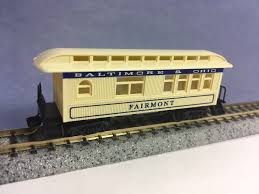What is a Monitor Roof Passenger Car?
Published: 2017-03-24 - By: Jenna
Last updated on: 2022-02-07
Last updated on: 2022-02-07
visibility: Public

In our efforts to create a comprehensive n-scale model trains database, we do two things. First, we consistently add more db items (current count is just shy of 37,000 locomotives, rolling stock, vehicles and accessories). Second, we try to feature as much variety as possible. That means adding old and new releases from a wide variety of model train manufacturers. It also entails adding items that are representative of the North American Model Rail Eras timeline* that we devised at the behest of the N Scale Enthusiast Society.
The Overton 34' coach cars (released from MDC Roundhouse in 2000) we recently added to the database (and to the Rewards page) represent Era 1 (1835-1900) passenger rolling stock. These items were modeled based on prototypes that came into service in the early 1860s and feature a Clerestory-style roof, which the railroads referred to as monitor, lantern, raised, deck, clear-story, elevated and steamboat roof. Prior to the so-called monitor roof, from 1840 to 1860, passenger cars sported an arched roof (pictured below).

Clerestory Roof
The Monitor roof is based on a centuries old architectural design known as clerestory. Passenger cars with this design featured a roof whose middle section was raised (about 18 inches) and whose sides had openings to allow for light and ventilation.
In actuality, the monitor roof had existed in the 1830s but the idea never took hold. Richard Imlay (a Baltimore-based carriage builder who built the first rail cars for the Baltimore and Ohio Railroad in 1828) built day coaches in the 1830s that featured clerestory-style roofs.
This clerestory design was revived by Webster Wagner as a way to assuage his sleeping car passengers complaining of stale air. The monitor roof allowed the stale air, which rose to the top, to be exhausted out of the cars via the raised roof vents. Wagner, whose cars ran on the New York Central and associated lines, built his first clerestory roof car in 1859.
Positive Reviews
This revival, which provided more sunlight and fresh air to enter cars, met with positive reviews and was praised in the American Railway Review. "The roof is raised in the centre, and in the sides of the elevated part are inserted twenty-eight ventilators, which preserve the air pure and sweet, and keep up a steady and healthful circulation -- a desideratum which has long been desired but which until now has never been supplied." (The American Railroad Passenger Car by John H. White, Jr. Part 1)
Soon after, this design was copied on day coaches. Many cars were remodeled with clerestory roofs in the 1860s.
It leaks!
The monitor roof did have its share of critics. Some were quite biased, especially those of Henry Ruttan, who wanted to sell his arched-roof air ventilators. However, there were quite valid complaints. It never truly solved the issue of stale air/poor ventilation; it added an additional production cost ($600/per car) and required higher maintenance (the roof's many joints and corners allowed for leaks and dirt catching). As a result, in the 1880s, a handful of car builders and railroads returned to arch-style roofs that featured very high arches (creating ample headroom and space for center lights). Nevertheless, the majority of the rail industry stuck with the monitor roof design, which persisted until the 1930s.
*Some months ago, the N Scale Enthusiast asked TroveStar to create an "Era" system similar to the NEM Standards (European) "Epoch" system. (Normen Europaischer M Modellbahnen (German) (NEM) are standards for model railroads issued by the MOROP, derived from "MOdellbahn" (German for "model railway") and EuROPe. The NEM Standards are defined and maintained by MOROP in collaboration with model railroad manufacturers. Prior to these de facto standards, modelers built layouts to their own specifications and each manufacturer created models based on a different standard -- making it impossible to interchange trains from one layout to another. Please see our blog, British Railway Eras

